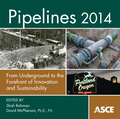Methods for Postconstruction Evaluation of Horizontal Directional Drilled Utilities
Publication: Pipelines 2014: From Underground to the Forefront of Innovation and Sustainability
Abstract
Trenchless technology has become an increasingly popular underground utility construction method. Beginning in the early 1900s with jacking beneath railroads, trenchless construction became more common throughout the century and into the current day. The utilization of horizontal directional drilling (HDD) technology is associated with the potential risk for ground subsidence and soil heaving. Sinkholes and settlement can form after construction, damaging existing infrastructure and causing safety hazards. HDD methods require an annular overcut, disturbing soil around the outer diameter of the utility being installed. While the annular overcut is necessary for feeding pipes through the borehole, when used in conjunction with a liquid lubricant, the likelihood for developing voids increases. The annular overcut is also a concern because the consistency and void ratio of the overburden soil change after boring or jacking. Inconsistent and void-ridden soil can cause void propagation through the overlying soil until it reaches the surface, where it will become a sinkhole or crack. This paper addresses postconstruction evaluation methods, especially pertaining to the annular space and void propagation region above and around a freshly installed utility installed by the horizontal directional drilling method in Southern Virginia. Two nondestructive evaluation methods are used to scan the surrounding soil: ground-penetrating radar (GPR) and FutureScan. FutureScan, a radar device developed by Louisiana Tech University, is capable of being attached to pipe inspection robots and uses a means of penetrating radar to detect voids and inconsistencies along the outer utility wall. This study examines the difference between GPR and FutureScan, regarding the imaging techniques used and the measured void ratios. All soil conditions for this study pertain to the Virginia Piedmont region. Relative elevations were recorded before, during, and after drilling to measure surface movement caused by drilling efforts. The relative elevation was also recorded several months after utility installation, so it could be compared at a long-term scale. Long-term results indicate whether or not the imaging techniques imply subsidence or heaving in the long term. After analysis was conducted using GPR and FutureScan, representative soil samples of the test site were retrieved and transported to a geotechnical laboratory for further testing. Based on the GPR and FutureScan findings, the utility of the two postconstruction evaluation methods was determined. The results were compared to the relative elevations recorded in the field. Void ratio field data and equipment reliability are limited to Virginia's Piedmont region.
Get full access to this article
View all available purchase options and get full access to this chapter.
Information & Authors
Information
Published In
Copyright
© 2014 American Society of Civil Engineers.
History
Published online: Aug 4, 2014
Authors
Metrics & Citations
Metrics
Citations
Download citation
If you have the appropriate software installed, you can download article citation data to the citation manager of your choice. Simply select your manager software from the list below and click Download.
